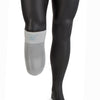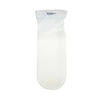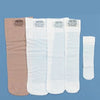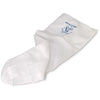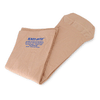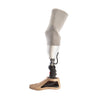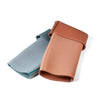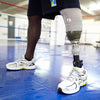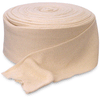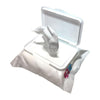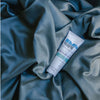How-to create a prosthetic skin care routine.
A Skin Care Regimen for Amputees
Any skin that comes in contact with your prosthesis needs to be well cared for in order to prevent damage that can affect your day-to-day comfort. Irritation, skin breakdown, and infection are all preventable, but how do you stop them before they start? By simply following an easy skin care routine you can identify these and other issues early and prevent down time, missing work, and avoidable medical expenses.
The Products You Need (and Why)
PROSTHETIC CLEANSER
Pick a pH balanced, soap-free prosthetic cleanser or wipe formulated for amputees with sensitive skin, preferably fragrance-free. A good cleanser will be compatible with your liner material and will remove dirt, sweat, and oils without stripping the skin of its natural moisture. Read more about prosthetic cleansers.
PROSTHETIC MOISTURIZER
Prosthetic Moisturizers are an essential skin care product. Moisturizing is critical for maintaining supple, healthy skin, and many amputees find that regularly conditioning the skin with lotions or creams makes it better able to withstand the stress of prosthetic use. Applying a moisturizing layer of protection to your residual limb before putting on the prosthetic socket can lessen the likelihood that you'll develop sores or abrasions. Applying a prosthetic moisturizer daily will also soften your skin, keeping it from cracking and drying out.
There are a variety of prosthetic moisturizing products available, so be sure to choose a product suited to your skin's needs. You can ask your Prosthetist or discover on Amputee Store a vitamin-based cream or lotion. People with naturally dry or cracked skin should look for a heavier, thicker product. Vaseline or petroleum-based lotions degrade some types of prosthetic liners, so ask your prosthetist before adding a new product to your skin care routine. Read Do I really need a Prosthetic Moisturizer?.
PROSTHETIC ANTIPERSPIRANT
Perspiration control is a big part of preventing abrasions and reducing odor caused by bacteria. The best way to prevent the numerous skin issues that can arise as a result of the warm, moist socket environment is to include antiperspirant and deodorant in your daily hygiene routine. An antiperspirant is designed to reduce and prevent perspiration build-up in sockets, and some are specifically manufactured for amputees. Antiperspirants typically contain aluminum, which temporarily blocks sweat ducts to prevent perspiration from happening. They may or may not include deodorant, which reduces how much you smell by killing bacteria. If you have sensitive skin, you'll be better off with a product that is fragrance free. Keep in mind that all-natural products don't contain aluminum, making them useful for deodorizing only. Read How Is That Different From Deodorant?.
TARGETED TREATMENTS
If abrasions from friction and rubbing do become an issue, you should consider using a lotion or anti-chafing product. Spot treatments can be applied to any minor cuts or abrasions before putting on your prosthetic sheath or liner, and anti-chafing products can be applied anywhere you're experiencing friction caused by repetitive socket movement. Don't forget to consult with your physician before applying any skincare product to open wounds.
What Should My Daily Prosthetic Routine Include?
This simple prosthetic routine covers the basics of what you should do every day to protect and care for your skin.
- Inspect all areas of your residual limb, including the back, all skin creases, and bony areas. Look for any signs of skin irritation, like peeling, cracking, blisters, or red marks that don't fade within 10 minutes of removing your prosthesis. As you become familiar with recurring problems, you'll learn which are minor enough for you to manage on your own and which you should report to your Prosthetist.
-
Wash and dry your limb properly. The skin of your residual limb should be washed each day with a mild cleanser and warm water. Rinse thoroughly with clean water to remove all traces of prosthetic cleanser, because any film left on the skin can cause problems later.
-
Dry your skin by blotting or patting it with a clean absorbent towel. Damp skin may swell inside the socket, causing you discomfort, so make sure your limb is completely dry before putting on your prosthesis. Waiting a few minutes for your limb to air-dry before applying your prosthesis is a good way to ensure that the skin is thoroughly dry.
- Apply moisturizer and spot treatment. The best time of the day to use moisturizing lotion is at night before bedtime or at another time when you won't be wearing your prosthesis. If you decide to apply a moisturizer before putting on your prosthesis, make sure the lotion is absorbed. Never apply skincare products to any open areas of your skin.
- Helpful Tip: Apply a spot treatment to any high friction areas on your limb.
-
Apply deodorant or antiperspirant. Before you put on your liner and prosthesis, apply an antiperspirant. Make sure it's dry before putting on your prosthetic liner.
- Wash any part of the interface that touches the skin. The socket, prosthetic sock, sheath, or liner that you wear should be washed thoroughly every day with warm water and soap. Make sure they're dried thoroughly before you put them on. A stump sock should be changed daily, washed as soon as it's taken off, and rinsed thoroughly. You can use a rubber ball to help it retain its shape.
- Inspect your other limb. For lower-extremity amputees, maintaining the health of your remaining foot is crucial. Inspecting your feet and toes for blisters, cuts, or cracking should be part of your daily routine. Before you put your shoes on check for tears, rough edges, or sharp objects that could lead to injury.
Related Articles:
- Alcohol & Skin Care: The Facts
- Do I have a skin disorder?
- How do amputees deal with friction?
- How Does Your Skin Work?
- Ingredients To Avoid
- Know Your Skin Type
- Parabens: Are they really a problem?
- The DOs and DON'Ts of Skin Care
- Why are fragrance free products best?
- Why do some skincare products cause a negative reaction?
- Your Residual Limb Deserves Some TLC
- 15 Skin Problems Amputees Experience & How to Solve Them
- Common Skin Issues for Above-Knee Amputees














































